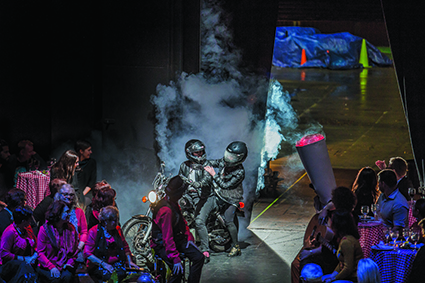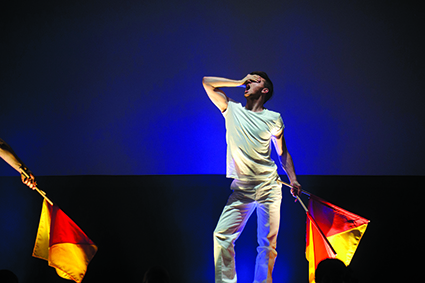Mingling memories, signs & connotations
John Bailey: Melbourne Performance
‘Theatre restaurant’ is a descriptor that brings with it a distinct set of connotations, and they’re of the sort that few outside the actual theatre restaurant industry hope to have bestowed upon them. It was with some rare delight that I saw a recent venture by Melbourne polymorphs Aphids consciously billed as “part theatre restaurant.” Of all the denigrated forms that have been reclaimed of late—pantomime, burlesque, variety—this was one I never saw coming.

A Singular Phenomenon, Aphids
photo Bryony Jackson
A Singular Phenomenon, Aphids
Aphids, A Singular Phenomenon
A Singular Phenomenon does indeed have something of the theatre restaurant atmosphere to it, not merely due to the serving of plates of pasta to audiences. It’s the proudly communitarian spirit the work aims towards, a question not so much of the low-brow populism we often associate with the theatre restaurant (or cruise ship, or corporate event) as a no-brow anything-goes approach that seems unaware of the existence of theatrical convention. It takes quite a bit of art to appear so unselfconsciously artless.
The work has at its centre a truly iconic Australian pop song of the 1980s that will be instantly recognisable if you’re over about 30, though it’s almost certain you haven’t thought about it for many, many years. I’m told that Aphids hopes to remount A Singular Phenomenon elsewhere and so I’m wary of revealing the song’s identity, but the piece is certainly stuffed with enough business and detours that foreknowledge would be unlikely to detract from the experience. Still, I’m keeping mum.
I can reveal that the structure of the work sees audience members assigned characters from the history of the song and its creator, and as an extended role call is announced these characters take their place upon the stage. No interaction is required beyond that; we’re merely placeholders and the random allocation of parts is democratic enough.
There are exceptions in the form of real people who loomed large in the song’s history, and who take to the stage as themselves. On opening night the reviewers in attendance were also summoned under their real titles, which initially struck me as juvenile—’outing’ critics while The Blackeyed Peas song “Shut Up” blares from speakers is oddly antagonistic in a work that is otherwise carnival and celebratory. But if we’re to be the representatives of authority in a dynamic that otherwise seeks to level power structures, then so be it.
Charting the biography of a song is an interesting premise, though this history is entirely sympathetic to its subject and there’s not much critical edge to it. The production occasionally strays into murkier territory, such as the spurious claims of child pornography the song’s creator was subjected to after posting images by a well-known international artist to Facebook. But thankfully the behind-the-scenes life of this figure, and the track itself, is full of enough bizarre detail and cultural significance to warrant a mere blow-by-blow recounting, which is finally what A Singular Phenomenon amounts to. To throw too much dialectical critique into the mix would perhaps be to its detriment.
The Living Museum of Erotic Women
The Living Museum of Erotic Women is another event that is wholly celebratory, in this case of a quite astonishing array of women across history. It’s set up as a sprawling installation spanning five storeys and while there’s a vague nod to UK theatre company Punchdrunk Sleep No More (2011) in layout, the similarities don’t extend too far. Performers in various rooms enact vignettes, soliloquies, dance and burlesque routines, and audiences are mostly free to wander between each with the occasional gathering for a special routine in a shared space.
The women performed range from the familiar—Mata Hari, Marlene Dietrich, Salome—to the more esoteric, such as the Mongol warrior Khutulun and Kabuki’s Izumo-no-Okuni. At times the focus on the erotic aspects of these appears outlandish. Joan of Arc seems a weird choice, for instance, but here proves a worthy one in a solo routine that produces uncomfortably sado-masochistic imagery of torture, resistance and ultimate defeat. The ‘She-Wolf’ Messalina is another memorable addition, snarling and prowling a space covered in severed penises, problematising the gaze of viewers by reminding them of their own precarious physicality and proximity.
This is, again, not a particularly critical work. For the most part it’s an unalloyed tribute to the spectacle of femininity, and if the function of spectacle and masquerade isn’t particularly questioned here, at least the variety of modalities through which that femininity can be expressed is encouragingly diverse. There’s also a certain queering of essentialism, with the artifice of representation never confused for the ‘real’. Some of the acts on offer suggest a rich sense of craft and subtle nuance, while others are charming in the simplicity of their intent.

Semaphore, Kate Neal
photo Sarah Walker
Semaphore, Kate Neal
Kate Neal, Semaphore
There’s no doubting the technical skill and rigorous discipline behind Kate Neal’s Semaphore, on the other hand. This is a consummate feat in sound and dance. Inspired by her father’s time spent working as a signalman in World War II, Neal draws on visual and auditory codes such as Semaphore and Morse code and refigures them in extraordinary ways.
Neal is a composer and the work is primarily sonic—a heavy emphasis on percussion sees the employment of dozens of drums, bells and other strikable objects, while even breath itself is choreographed in percussive ways. The sharply regimented syncopation at times slides into ravishing piano glissandi and arpeggiated strings, suggestive of the rolling seas the signalman traversed, while brief sequences of animation and video provide context from Neal’s father himself.
All of this would make for a terribly fine work, so it’s quite an accomplishment that the addition of a potent dance element doesn’t distract or muddle the focus. Timothy Walsh’s choreography bleeds into Neal’s composition as semaphore flags slice the air with audible snaps and flutters, while the musicians are given movements that make their own performances dance-like. The bright red and yellow of the swung flags is made more pronounced by a gentle aura of blue light, and thick haze effects make more solid the air in which these signifiers mingle. If the staccato telegraph and the blinking signal light can be considered their own forms of language, Neal has proven that they’re as capable of poetry as any other.
Aphids, A Singular Phenomenon, creators Lara Thoms with Aaron Orzech, Liz Dunn, original project development by Tristan Meecham, The Merlyn, Malthouse Theatre, 2–23 May; Bernzerk Productions, The Living Museum of Erotic Women, director Willow J Conway, End to End Building, Collingwood, 12 May–7 June; Semaphore, composer, concept: Kate Neal, director Laura Sheedy, choreographer, dancer: Timothy Walsh, animation, video: Sal Cooper, Arts House, North Melbourne Town Hall, 27-31 May
RealTime issue #127 June-July 2015 pg. 43






